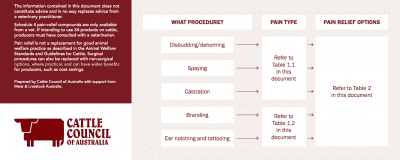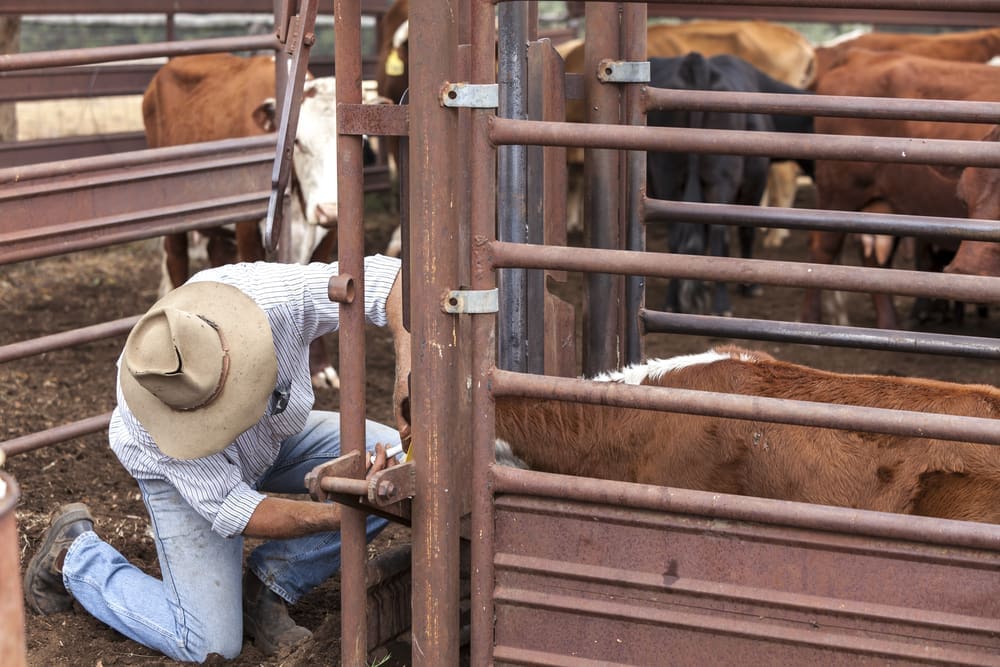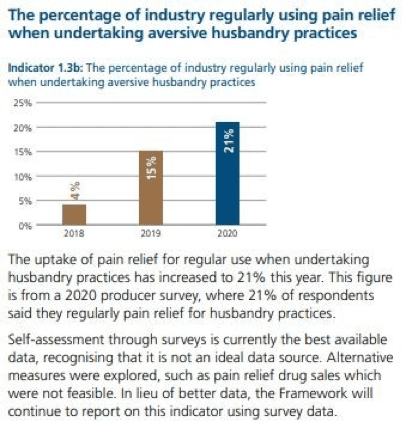Producers making decisions on which pain relief strategy to use in which circumstance now have a useful guide to draw on, developed by Cattle Council of Australia (CCA).
The list of pain relief options for use in commercial cattle operations has grown significantly in recent years.
Products now available range from the over-the-counter anaesthetic and antiseptic spray Trisolfen to numerous veterinary and prescription-only products including anaesthetic injections and non-steroidal anti-inflammatory treatments such as the meloxicam Buccalgesic cheek pouch gel and Metacam injection.

The CCA pain relief guide can be downloaded at this link
Each of the various registered pain relief compounds has a different purpose.
A three-page Pain Relief Guide recently released by CCA provides guidance to help producers match planned procedures with the most relevant compound or combination of compounds – while also emphasising that where any uncertainty exists producers should seek advice from a veterinarian.
The guide was developed over a period of about eight months by the CCA’s Animal Health, Welfare, Biosecurity and Environment (AH,W & B) Taskforce, in consultation with industry, veterinarians and animal welfare groups.
It provides a summary of registered pain relief products, a guide to the indicative price per head of each, and lists pain relief options for procedures such as castration, dehorning, spaying, branding and ear marking.
It is hard to put a definitive figure on how many producers now use pain relief products in their operations, but it is clear uptake has grown rapidly in recent years.
The 2020 Australian Beef Sustainability Framework update report released earlier this year contained an estimate from a Meat & Livestock Australia survey suggesting that about 21 percent of Australian beef cattle producers now use pain relief in their cattle operations, up from four percent in 2018.
Queensland cattle producer Bim Struss, who chairs CCA’s Animal Health, Welfare, Biosecurity and Environment (AHW & B) Taskforce and talks regularly with veterinarians across the industry nationally, believes the actual percentage of producers using pain relief across the industry would be higher than suggested in the MLA survey.
He said anecdotal feedback he has received from vets in some of the larger cattle producing regions of Queensland suggest that over 50 percent of producers in their areas are now routinely using pain relief.
He said one vet recently made the illustrative observation that he could not think of a single producer who had started to use pain relief who had not continued to do so.
Where does regulation stand on pain relief usage?
At present the decision about whether to use pain relief products on cattle is voluntary in most States or Territories, but Governments in each jurisdiction have indicated an intention to enshrine the requirements of the Animal Welfare Standards for Cattle into their respective State/Territory laws.
The Animal Welfare Standards for Cattle require the use of pain relief for castration and dehorning of animals above certain ages (for details for each state Animal Welfare Standards and Guidelines for Cattle (Standards 6.2 and 6.4).
Mr Struss said the high rate of voluntary take up of pain relief usage so far showed a strong level of leadership by industry.
“It shows that this is something that we as an industry are not being forced to do but we want to do and we feel it is important,” he said.
“I get asked sometimes if I can prove there will actually be a dollar benefit at the end.
“I can’t prove that, and I don’t think anybody can prove that, but ultimately I believe market signals will determine usage.
‘ultimately I believe market signals will determine usage’
“Ultimately our markets are going to get harder – cattle numbers in Argentina and Brazil are increasing and they are getting better at the way they handle and market their cattle.
“We need to be above the pack and this is another opportunity where we can show to importers that Australia is leading the pack and has best policies of husbandry”.
He said he had also been surprised by the particularly strong rate of take up in the more extensive herds of northern Australia in recent years, while feedback from CCA representatives in southern States suggested rates of uptake have increased strongly in Southern Australia as well.
Mr Struss said the feedback to the CCA’s pain relief guide released earlier this year had been very positive.
Some producers had questioned whether industry leadership was on the right track, expressing concern that usage may soon be regulated, but he said that under the Animal Welfare Standards and Guidelines pain relief is already compulsory for cattle over six months of age.
“There is a regulation there in our standards and guidelines that we are meant to be using pain relief for anything we are doing over six months.
“The number of cattle we would be doing over six months I think would be very, very few.”
The CCA pain relief guide can be downloaded at this link






When is the pain killer needed, surely not for your regulated ear tag or a bit of worm pour on? That’s my only two procedures.